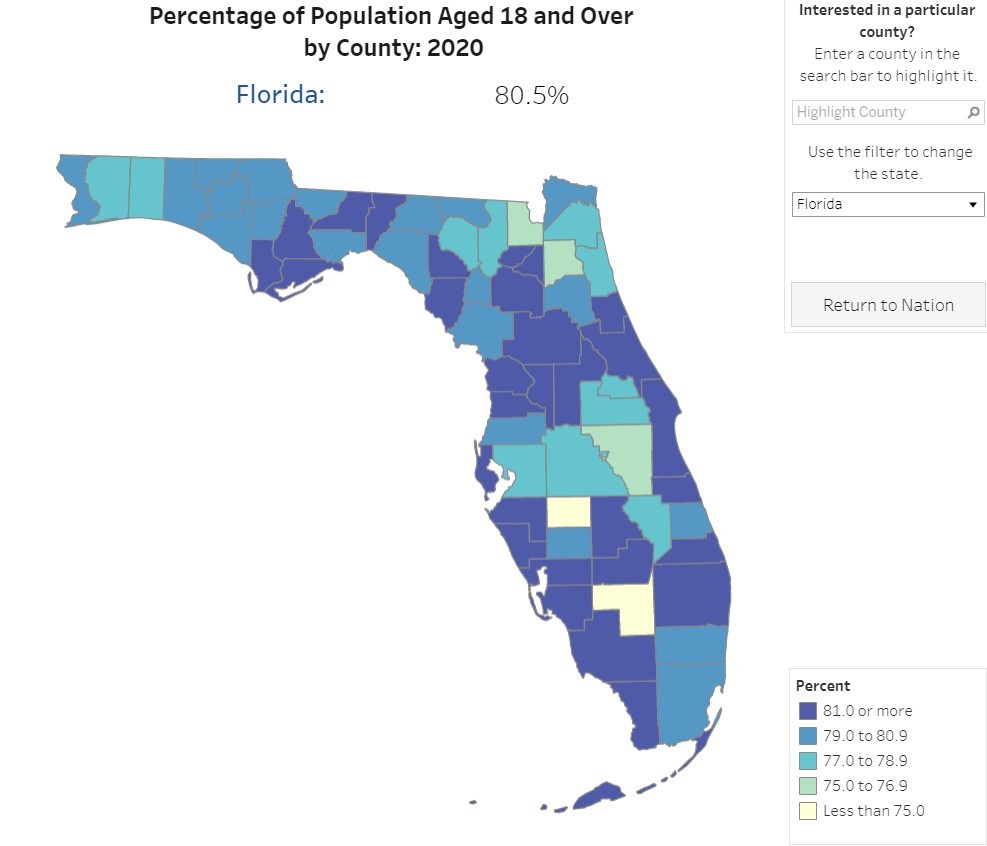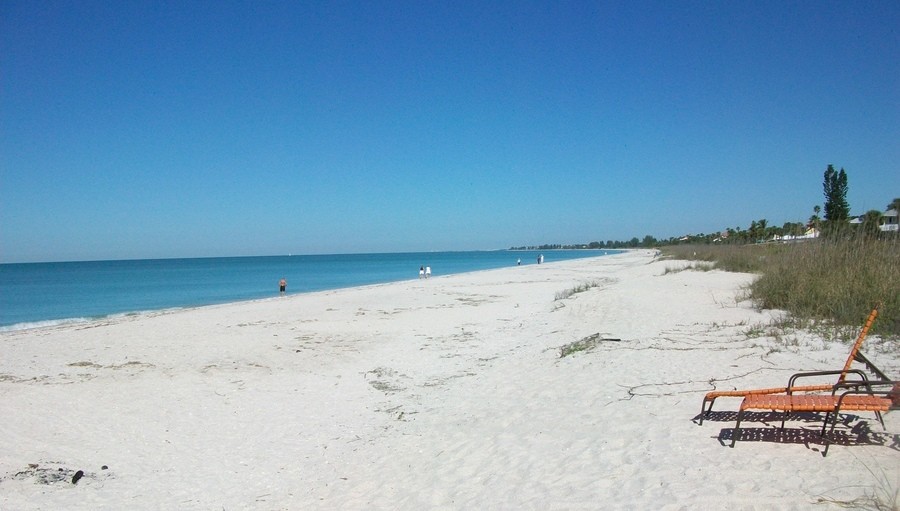SRQ DAILY Aug 14, 2021

"As much as we hold dearly to the value of an affordable liberal arts education, we also embrace the fact that some things do need to change."



The release of critical Census data on Thursday showed significant changes and the different ways in which Sarasota and Manatee are growing. Both counties have grown, but in Sarasota, the population has become slightly older and not nearly as ethnically diverse as its neighbor to the north.
In Sarasota County, those older than 18 make up 86.3% of the county and children make up just 13.7% of the population. I’d love to see more data on further breakdowns, but that shows that the county as a whole remains a long-term home primarily to retirees, those who are no longer raising school-aged children. By comparison, Census counters a decade ago found children made up a 2-percentage-point greater share of the overall population.
That means Sarasota has the third-highest adult population of Florida’s 67 counties. That’s behind only neighboring Charlotte, where 87.9% of the population is over the age of 18, and Sumter County, where the growing population of The Villages means a whopping 93% of residents have put their childhood behind them (and their children’s childhood most likely).
But Manatee is a different story. About 81.7% of the population there is over age 18. That puts it at No. 23 among Florida counties, still on the high end of agedness but still with a fair share of family and kids. Now, the percentage of children still dropped over the decade, from 20.5% in 2010 to 18.3% in 2020. But it’s still closer the statewide makeup of 80.5% adults, 19.5% kids. Nationwide, 77.9% of all residents are over the age of 18.
Florida also has become more racially diverse, but not in every corner. While the Census “diversity index” for Florida leapt from 59.1% in 2010 to 64.1% in 2020, the biggest changes seemed concentrated close to the major metros. Hillsborough County, Florida’s third most diverse, had a 67.8% index but communities to its immediate south were less like a melting por.
In Manatee, the index is 49.4%. In Sarasota, it’s 33.8%. Go even further and it’s only 31.4% in Charlotte. By comparison, the indexes in 2010 came in around 43.2% in Manatee, 27.1% in Sarasota and 25.3% in Charlotts
The Hispanic/Latino population has driven much of the growth. In 2010, about 14.9% of Manatee residents fell in that classification while 17.8% do today. In Sarasota, the demographic makes up 10% of the county compared to 7.9% a decade ago. Meanwhile, the percentage of Black residents in both counties has gone down, from 8.4% in Manatee and 4.5% in Sarasota in 2010 to 7.8% and 3.7% respectively now.
It’s pure speculation to derive the political consequence of all this. But there’s also rumors a traditionally Black-held state House seat may not need to stretch south from St. Petersburg all the way to Sarasota after next year's redistricting, and these numbers may fuel that. This could also play a role in the inevitable Sarasota County redistricting, where you may remember legal challenges centered on the impacts to Sarasota’s Black community.
But there’s also something to consider in Manatee, with both state seats and county posts, as far as Hispanic representation. It will take some time to derive information about the concentrations of ethnic populations but there’s as much question as ever about what priority gets placed on representation for the region’s Hispanic residents.
As for questions of age, many have long lamented the seemingly outsized voice of the older retiree population on Sarasota politics, but this data shows it may not be outsized at all. Certainly, there’s no indication it will change any time soon.
Jacob Ogles is contributing senior editor of SRQ MEDIA. 
Graphic from Census.gov



It seems poetic, in a way, that I begin my first experience as a college president during such a transformative time in our history—and at such a place as New College of Florida.
Things have been shifting so rapidly in our world—certainly in the higher education world—throughout the past year, pushing us to question the status quo and challenging us to reimagine what we really want from our future.
New College is evolving, too. And it inspires me to be a part of this change.
So what’s changing? Well, first off, some things never should and never will—like how invaluable a liberal arts and honors education can be, and how the experience cultivates the kind of global citizens that create the most innovative solutions to the oldest problems.
I come from a liberal arts background, and I have no shortage of stories (some of which I may share with you in the coming months) about the impact it had on me. I look forward to hearing your stories, too, about the transformative power of a liberal arts education.
Something else that must never change is our commitment to affordable education. Many of New College’s peers are private institutions, with price tags sometimes exceeding $75,000. Even with financial aid, few families can afford such costs. New College is a public institution and a proud member of Florida’s State University System—the top-ranked state university system, according to U.S. News & World Report. Our in-state tuition and fees, including room and board, are $17,458, and nearly all of our students receive some form of financial aid. Almost 60% of our students graduate with zero debt, compared to the national average of 42%.
But, as much as we hold dearly to the value of an affordable liberal arts education, we also embrace the fact that some things do need to change. New College was founded on a spirit of innovation and, already in my first few weeks on campus, I am proud to say that this spirit is alive and well here.
One of the emerging changes that most excites me is New College’s approach to career education. For too long, students in the liberal arts received few, if any, opportunities for true career exploration and development. At some schools, it’s almost taboo to talk about professions and careers—as if doing so somehow negates the full value and benefit of a liberal arts education.
But New College is leading the way in realizing a new vision for career education—one that is fully integrated into the academic experience. New College students are assigned individual career coaches before they even arrive on campus, our first-year seminars combine academics with career exploration, our alumni are serving as professional mentors, our faculty are sharing new ways of integrating career education into the curriculum, and we are focusing on internships more than ever. Our goal is to have 100 percent of our students pursue at least one internship for academic credit before they graduate.
Another thing I’d like to see change is the perception that New College is a “hidden gem.” It amazes me that, even with our exquisite waterfront campus and world-class educational experience, there are still people in our community who are unfamiliar with what New College offers.
The bayfront is our backyard, we’re only a short trip from the world’s best beaches, and our students and professors don’t have to travel at all to conduct cutting-edge marine research. Together, they are monitoring the health of sharks, dolphins and manatees; and improving the sustainability of mangroves and other native plants in our region—work that directly benefits Florida’s landscape and economy. I want the world to know how our students and faculty are, on a daily basis, affecting real change.
Change is critical, though sometimes a little stressful and scary, as I’ve learned this past year. Major shifts have occurred in my own life. Within one six-week period, I accepted a new job and ended another after 31 years (with the University of Missouri, as the dean of the College of Arts and Science, and a professor of English). My husband and I moved with my 89-year-old mother and our golden retriever halfway across the country. We bought a house, sold another and combined two households, all while our two adult children also moved.
While we waited for a furniture delivery that was delayed, we anxiously watched the news as Hurricane Elsa seemed headed for our house.
But, moving stress aside, we are thrilled to be living in one of Time magazine’s 100 “World’s Greatest Places of 2021.” We love the fact that relatives are visiting us like never before.
I’m excited to be leading a college dedicated to preparing students for lives of great achievement. And I’m honored to get to know all of you—the members of this incredible community—as we move forward and change together.
Patricia Okker, Ph.D. is the president of New College of Florida. 

SRQ DAILY is produced by SRQ | The Magazine. Note: The views and opinions expressed in the Saturday Perspectives Edition and in the Letters department of SRQ DAILY are those of the author(s) and do not imply endorsement by SRQ Media. Senior Editor Jacob Ogles edits the Saturday Perspective Edition, Letters and Guest Contributor columns.In the CocoTele department, SRQ DAILY is providing excerpts from news releases as a public service. Reference to any specific product or entity does not constitute an endorsement or recommendation by SRQ DAILY. The views expressed by individuals are their own and their appearance in this section does not imply an endorsement of them or any entity they represent. For rates on SRQ DAILY banner advertising and sponsored content opportunities, please contact Ashley Ryan Cannon at 941-365-7702 x211 or via email |
Powered by Sarasota Web Design | Unsubscribe













